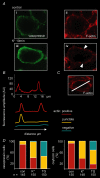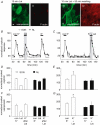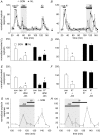The role of the actin cytoskeleton in oxytocin and vasopressin release from rat supraoptic nucleus neurons
- PMID: 17478532
- PMCID: PMC2075266
- DOI: 10.1113/jphysiol.2007.132639
The role of the actin cytoskeleton in oxytocin and vasopressin release from rat supraoptic nucleus neurons
Abstract
Magnocellular neurons of the supraoptic nucleus (SON) can differentially control peptide release from the somato/dendritic and axon terminal compartment. Dendritic release can be selectively regulated through activation of intracellular calcium stores by calcium mobilizers such as thapsigargin (TG), resulting in preparation (priming) of somato/dendritic peptide pools for subsequent activity-dependent release. As dynamic modulation of the actin cytoskeleton is implicated in secretion from synaptic terminals and from several types of neuroendocrine cells, we studied its involvement in oxytocin and vasopressin release from SON neurons. Confocal image analysis of the somata revealed that the normally continuous cortical band of F-actin is disrupted after high potassium (K(+), 50 mm) or TG (200 nm) stimulation. The functional importance of actin remodelling was studied using cell-permeable actin polymerizing (jasplakinolide, 2 microm) or depolymerizing agents (latrunculin B, 5 microm) to treat SON and neural lobe (NL) explants in vitro and measure high K(+)-induced oxytocin and vasopressin release. Latrunculin significantly enhanced, and jasplakinolide inhibited, high-K(+)-evoked somato/dendritic peptide release, while release from axon terminals was not altered, suggesting that high-K(+)-evoked release in the SON, but not the NL, requires depolymerization of the actin cytoskeleton. TG-induced priming of somato/dendritic release was also blocked by jasplakinolide and latrunculin, suggesting that priming involves changes in actin remodelling.
Figures




Similar articles
-
The involvement of voltage-operated calcium channels in somato-dendritic oxytocin release.PLoS One. 2011;6(10):e25366. doi: 10.1371/journal.pone.0025366. Epub 2011 Oct 20. PLoS One. 2011. PMID: 22028774 Free PMC article.
-
Regulation of activity-dependent dendritic vasopressin release from rat supraoptic neurones.J Physiol. 2005 Apr 15;564(Pt 2):515-22. doi: 10.1113/jphysiol.2005.083931. Epub 2005 Feb 24. J Physiol. 2005. PMID: 15731188 Free PMC article.
-
Neurosteroid regulation of oxytocin and vasopressin release from the rat supraoptic nucleus.J Physiol. 2003 Apr 1;548(Pt 1):233-44. doi: 10.1113/jphysiol.2002.036863. Epub 2003 Feb 14. J Physiol. 2003. PMID: 12588901 Free PMC article.
-
The actin filament and dendritic peptide release.Biochem Soc Trans. 2007 Nov;35(Pt 5):1243-6. doi: 10.1042/BST0351243. Biochem Soc Trans. 2007. PMID: 17956322 Review.
-
Modulation of synaptic transmission by oxytocin and vasopressin in the supraoptic nucleus.Prog Brain Res. 2002;139:235-46. doi: 10.1016/s0079-6123(02)39020-4. Prog Brain Res. 2002. PMID: 12436939 Review.
Cited by
-
Thermodynamic Efficiency of Somatic Exocytosis of Serotonin.Front Physiol. 2019 May 31;10:473. doi: 10.3389/fphys.2019.00473. eCollection 2019. Front Physiol. 2019. PMID: 31214038 Free PMC article.
-
The involvement of voltage-operated calcium channels in somato-dendritic oxytocin release.PLoS One. 2011;6(10):e25366. doi: 10.1371/journal.pone.0025366. Epub 2011 Oct 20. PLoS One. 2011. PMID: 22028774 Free PMC article.
-
Interaction of extracellular signal-regulated protein kinase 1/2 with actin cytoskeleton in supraoptic oxytocin neurons and astrocytes: role in burst firing.J Neurosci. 2007 Dec 12;27(50):13822-34. doi: 10.1523/JNEUROSCI.4119-07.2007. J Neurosci. 2007. PMID: 18077694 Free PMC article.
-
Neuropeptide transmission in brain circuits.Neuron. 2012 Oct 4;76(1):98-115. doi: 10.1016/j.neuron.2012.09.014. Neuron. 2012. PMID: 23040809 Free PMC article. Review.
-
Endoplasmic Reticulum and Mitochondrial Calcium Handling Dynamically Shape Slow Afterhyperpolarizations in Vasopressin Magnocellular Neurons.J Neurosci. 2024 Jul 24;44(30):e0003242024. doi: 10.1523/JNEUROSCI.0003-24.2024. J Neurosci. 2024. PMID: 38937101 Free PMC article.
References
-
- Aunis D, Bader MF. The cytoskeleton as a barrier to exocytosis in secretory cells. J Exp Biol. 1988;139:253–266. - PubMed
-
- Borisy GG, Svitkina TM. Actin machinery: pushing the envelope. Curr Opin Cell Biol. 2000;12:104–112. - PubMed
-
- Bubb MR, Senderowicz AM, Sausville EA, Duncan KL, Korn ED. Jasplakinolide, a cytotoxic natural product, induces actin polymerization and competitively inhibits the binding of phalloidin to F-actin. J Biol Chem. 1994;269:14869–14871. - PubMed
Publication types
MeSH terms
Substances
Grants and funding
LinkOut - more resources
Full Text Sources
Research Materials
Miscellaneous

